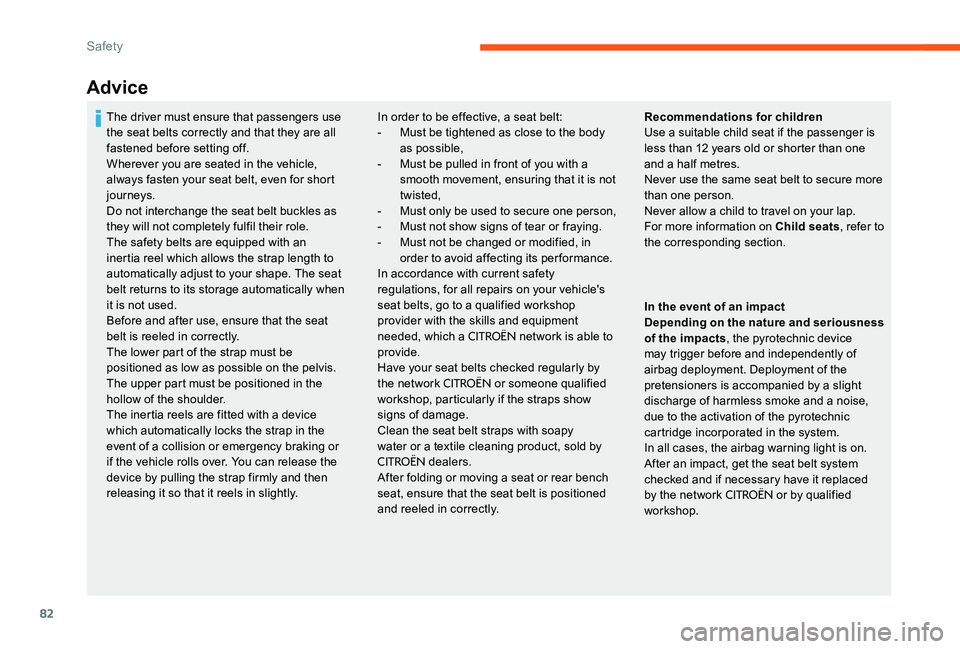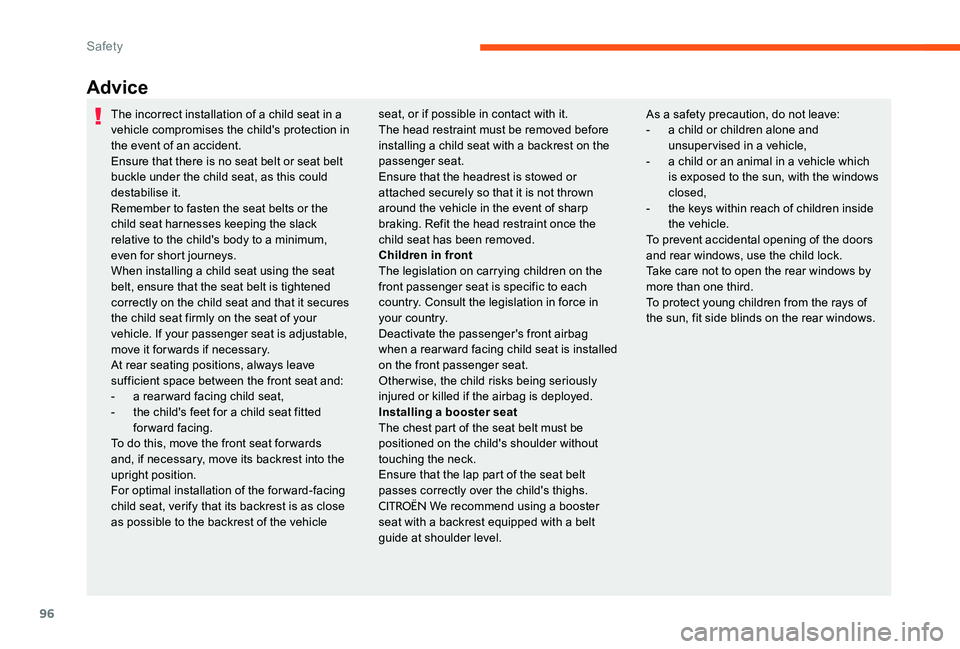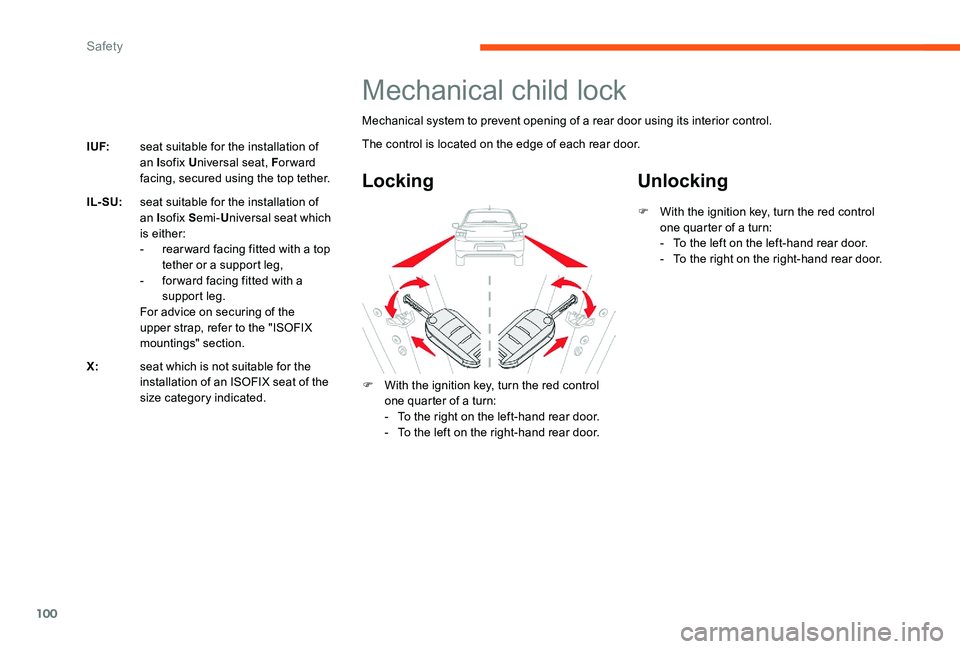lock CITROEN C-ELYSÉE 2017 Handbook (in English)
[x] Cancel search | Manufacturer: CITROEN, Model Year: 2017, Model line: C-ELYSÉE, Model: CITROEN C-ELYSÉE 2017Pages: 306, PDF Size: 9.34 MB
Page 82 of 306

80
Seat belts
Front seat belts
LockingSeat belt not fastened /
unfastening warning light
When the ignition is switched on,
this warning light comes on in the
instrument panel, if the driver has
not fastened his/her seat belt.
From approximately 12 mph (20 km/h),
this warning light flashes for two minutes
accompanied by an audible signal of increasing
volume. Once these two minutes have elapsed,
this warning light remains on until the driver
fastens their seat belt.
This warning lamp also illuminates in the
instrument panel if the driver and/or front
passenger unfastens his/her seat belt while
driving.*
The front seat belts are fitted with a pyrotechnic
pretensioning and force limiting system.
This system improves safety in the front
seats in the event of a front or side impact.
Depending on the severity of the impact, the
pretensioning system instantly tightens the seat
belts against the body of the occupants.
The pretensioning seat belts are active when
the ignition is on.
The force limiter reduces the pressure of the
seat belt on the chest of the occupant, thus
improving their protection. F
P
ull the strap then insert the tongue in the
buckle.
F
C
heck that the seat belt is fastened
correctly by pulling the strap.
Unlocking
F Press the red button on the buckle.
F G uide the seat belt as it reels in.
* Depending on the country of sale.
Safety
Page 83 of 306

81
Rear seat belts
Locking
F Pull the strap then insert the tongue in the buckle.
F
C
heck that the seat belt is fastened
correctly by pulling the strap.
Unlocking
F Press the red button on the buckle.
F G uide the seat belt as it reels in.
The right and left rear seats are each fitted with
a three-point inertia reel seat belt.
Depending on version, the centre rear seat is
fitted with a seat belt with or without reel, and
has three or two-point anchorages.
5
Safety
Page 84 of 306

82
Advice
In order to be effective, a seat belt:
- M ust be tightened as close to the body
as possible,
-
M
ust be pulled in front of you with a
smooth movement, ensuring that it is not
twisted,
-
M
ust only be used to secure one person,
-
M
ust not show signs of tear or fraying.
-
M
ust not be changed or modified, in
order to avoid affecting its per formance.
In accordance with current safety
regulations, for all repairs on your vehicle's
seat belts, go to a qualified workshop
provider with the skills and equipment
needed, which a
CITROËN network is able to
provide.
Have your seat belts checked regularly by
the network
CITROËN or someone qualified
workshop, particularly if the straps show
signs of damage.
Clean the seat belt straps with soapy
water or a textile cleaning product, sold by
CITROËN dealers.
After folding or moving a seat or rear bench
seat, ensure that the seat belt is positioned
and reeled in correctly. Recommendations for children
Use a suitable child seat if the passenger is
less than 12 years old or shorter than one
and a half metres.
Never use the same seat belt to secure more
than one person.
Never allow a child to travel on your lap.
For more information on Child seats
, refer to
the corresponding section.
In the event of an impact
Depending on the nature and seriousness
of the impacts , the pyrotechnic device
may trigger before and independently of
airbag deployment. Deployment of the
pretensioners is accompanied by a slight
discharge of harmless smoke and a noise,
due to the activation of the pyrotechnic
cartridge incorporated in the system.
In all cases, the airbag warning light is on.
After an impact, get the seat belt system
checked and if necessary have it replaced
by the network
CITROËN or by qualified
workshop.
The driver must ensure that passengers use
the seat belts correctly and that they are all
fastened before setting off.
Wherever you are seated in the vehicle,
always fasten your seat belt, even for short
journeys.
Do not interchange the seat belt buckles as
they will not completely fulfil their role.
The safety belts are equipped with an
inertia reel which allows the strap length to
automatically adjust to your shape. The seat
belt returns to its storage automatically when
it is not used.
Before and after use, ensure that the seat
belt is reeled in correctly.
The lower part of the strap must be
positioned as low as possible on the pelvis.
The upper part must be positioned in the
hollow of the shoulder.
The inertia reels are fitted with a device
which automatically locks the strap in the
event of a collision or emergency braking or
if the vehicle rolls over. You can release the
device by pulling the strap firmly and then
releasing it so that it reels in slightly.
Safety
Page 98 of 306

96
Advice
The incorrect installation of a child seat in a
vehicle compromises the child's protection in
the event of an accident.
Ensure that there is no seat belt or seat belt
buckle under the child seat, as this could
destabilise it.
Remember to fasten the seat belts or the
child seat harnesses keeping the slack
relative to the child's body to a minimum,
even for short journeys.
When installing a child seat using the seat
belt, ensure that the seat belt is tightened
correctly on the child seat and that it secures
the child seat firmly on the seat of your
vehicle. If your passenger seat is adjustable,
move it for wards if necessary.
At rear seating positions, always leave
sufficient space between the front seat and:
-
a r
ear ward facing child seat,
-
t
he child's feet for a child seat fitted
forward facing.
To do this, move the front seat for wards
and, if necessary, move its backrest into the
upright position.
For optimal installation of the forward-facing
child seat, verify that its backrest is as close
as possible to the backrest of the vehicle seat, or if possible in contact with it.
The head restraint must be removed before
installing a child seat with a backrest on the
passenger seat.
Ensure that the headrest is stowed or
attached securely so that it is not thrown
around the vehicle in the event of sharp
braking. Refit the head restraint once the
child seat has been removed.
Children in front
The legislation on carrying children on the
front passenger seat is specific to each
country. Consult the legislation in force in
your country.
Deactivate the passenger's front airbag
when a rear ward facing child seat is installed
on the front passenger seat.
Otherwise, the child risks being seriously
injured or killed if the airbag is deployed.
Installing a booster seat
The chest part of the seat belt must be
positioned on the child's shoulder without
touching the neck.
Ensure that the lap part of the seat belt
passes correctly over the child's thighs.
CITROËN We recommend using a booster
seat with a backrest equipped with a belt
guide at shoulder level. As a safety precaution, do not leave:
-
a c
hild or children alone and
unsupervised in a vehicle,
-
a c
hild or an animal in a vehicle which
is exposed to the sun, with the windows
closed,
-
t
he keys within reach of children inside
the vehicle.
To prevent accidental opening of the doors
and rear windows, use the child lock.
Take care not to open the rear windows by
more than one third.
To protect young children from the rays of
the sun, fit side blinds on the rear windows.
Safety
Page 102 of 306

100
I UF:seat suitable for the installation of
an Isofix U niversal seat, F or ward
facing, secured using the top tether.
IL- SU: seat suitable for the installation of
an Isofix S emi-Universal seat which
is either:
-
r
ear ward facing fitted with a top
tether or a support leg,
-
f
or ward facing fitted with a
support leg.
For advice on securing of the
upper strap, refer to the "ISOFIX
mountings" section.
X: seat which is not suitable for the
installation of an ISOFIX seat of the
size category indicated.
Mechanical child lock
Mechanical system to prevent opening of a rear door using its interior control.
The control is located on the edge of each rear door.
Locking Unlocking
F With the ignition key, turn the red control
one quarter of a turn:
-
T
o the right on the left-hand rear door.
-
T
o the left on the right-hand rear door. F
W
ith the ignition key, turn the red control
one quarter of a turn:
-
T
o the left on the left-hand rear door.
-
T
o the right on the right-hand rear door.
Safety
Page 104 of 306

102
Starting-switching off the engine
Anti-theft protection
Electronic engine immobiliser
The key contains an electronic chip which has
a special code. When the ignition is switched
on, this code must be recognised in order for
starting to be possible.
This electronic engine immobiliser locks the
engine management system a few minutes
after the ignition is switched off, and prevents
the engine being started by anyone who does
not have the key.
or In the event of a fault, you are
informed by the illumination of this
warning light, an audible signal and
a message in the screen.
In this case, your vehicle will not start; contact
a
CITROËN dealer as soon as possible.
Keep safely, away from your vehicle, the
label attached to the keys given to you on
when you purchased your vehicle.
Key star ter
It has 3 positions:
- position 1 (Stop): insert and removing the
key, steering column locked,
-
position 2 (Ignition on) : steering column
unlocked, ignition on, Diesel preheating,
engine running,
-
position 3 (Starting) .
Ignition on position
It allows the use of the vehicle's electric
equipment or portable devices to be charged.
Once the state of charge of the battery drops
to the reserve level, the system switches to
energy economy mode: the power supply is
cut off automatically to preserve the remaining
battery charge.
Avoid attaching heavy objects to the key
or the remote control, which would weigh
down on its blade in the ignition switch
and could cause a malfunction.
It could adversely affect the deployment of
the front airbag.
Driving
Page 105 of 306

103
Starting the engine
The parking brake must be applied.
F
W
ith a manual gearbox, place the gear
lever in neutral then depress the clutch
pedal fully.
F
W
ith an automatic gearbox, select position
P, then firmly press the brake pedal.
F
W
ith an electronic gearbox, select position
N then firmly press the brake pedal.
F
I
nsert the key into the ignition switch; the
system recognises the code.
F
U
nlock the steering column by
simultaneously turning the steering and the
key.
In certain cases, you may have to turn
the steering wheel energetically to move
the wheels (for example if the wheels are
braced against a kerb). F
W ith a petrol engine, operate the starter
motor by turning the key to position 3
without pressing the accelerator pedal,
until the engine starts. Once the engine is
running, release the key.
F
W
ith a Diesel engine, turn the key to
position 2 , ignition on, to operate the
engine pre-heating system.
Wait until this warning light goes off
in the instrument panel then operate
the starter motor by turning the key
to position 3 without pressing the
accelerator pedal, until the engine
starts. Once the engine is running,
release the key.
In winter conditions, the lighting time of
the indicator light is longer. When the
engine is warm, the indicator light does
not come on. If the engine does not start immediately,
turn off the ignition. Wait a few minutes
before restarting. If after a few attempts
the engine does not start, do not persist:
you risk damaging the starter and the
engine. Contact a
CITROËN dealer or a
qualified workshop.
In temperate conditions, do not leave
the engine at idle to warm up but move
off straight away and drive at moderate
speed.
Never leave the engine running in
an enclosed area without adequate
ventilation: internal combustion engines
emit toxic exhaust gases, such as carbon
monoxide. There is a risk of poisoning and
death!
In severe wintry conditions (temperature
below -23°C), the engine should be left at
idle for four minutes before moving off to
ensure the correct operation and life of the
mechanical parts of your vehicle, engine
and gearbox.
6
Driving
Page 106 of 306

104
Switching off the engine
F Stop the vehicle.Energy savings mode
For more information on the Energy
economy mode refer to the
corresponding section.
F
W
ith the engine running in idle, turn the key
to position 1 .
F
R
emove the key from the ignition switch.
F
T
o lock the steering column, turn the
steering until it locks.
To facilitate unlocking of the steering column,
it is recommended that the wheels be
returned to the straight ahead position
before switching off the engine.
F
C
heck that the parking brake is
correctly applied, particularly on
sloping ground. After switching off the engine (position
1- Stop
), for a maximum of 30 minutes you
can still use functions such as the audio and
communications system, the wipers, dipped
beam headlights, courtesy lights, ...
Never turn the ignition off before the
vehicle is at a complete stop. With the
engine off, the braking and steering
assistance systems are also cut off: risk
of loss of control of the vehicle.
When you leave the vehicle, keep the key
with you and lock the vehicle.
When opening the driver's door, an alert
message is displayed, accompanied by
an audible signal, to remind you that the
key is still in the ignition switch at position
1 (Stop) .
If the key has been left in the ignition
switch at position 2 (Ignition on) , the
ignition will be switched off automatically
after one hour.
To switch the ignition back on, turn the key
to position 1 (Stop) , then back to position
2 (Ignition on) .
Key left in the "Ignition on" position
Driving
Page 107 of 306

105
Parking brake
LockingUnlocking
F Pull the parking brake lever up slightly,
press the release button, then lower the
lever fully.
When parking on a slope, direct your
wheels against the kerb, apply the parking
brake, engage a gear and switch off the
ignition. When the vehicle is being driven,
if this warning light and the STOP
warning light come on, accompanied
by an audible signal and a message
in the screen, this indicates that the
parking brake is still on or has not
been fully released.
Manual gearbox
Engaging reverse gear
F Press the clutch pedal fully down.
F
P
ush the gear lever fully to the right then
backwards.
F
P
ull the parking brake lever up to
immobilise your vehicle.
As a safety precaution and to facilitate
starting of the engine:
-
a
lways select neutral,
-
p
ress the clutch pedal.
Only engage reverse gear when the
vehicle is stationary with the engine at idle.
6
Driving
Page 136 of 306

134
Recommendations on storage
AdBlue® freezes below around -11°C and
deteriorates above 25°C. It is recommended
that bottles or containers be stored in a cool
place and protected from direct sunlight.
Under these conditions, the fluid can be kept
for at least a year.
If the fluid has frozen, it can be used once
it has completely thawed out at ambient
temperature.
Never store bottles or containers of
AdBlue
® in your vehicle.
Do not dispose of AdBlue
® bottles or
containers in the household waste.
Place them in a container provided for
this purpose or take them to your dealer.
Procedure
Before topping-up, ensure that the vehicle is
parked on a flat and level sur face.
In wintry conditions, ensure that the
temperature of the vehicle is above -11°C.
Otherwise the AdBlue
® may be frozen and
so cannot be poured into its tank. Park your
vehicle in a warmer area for a few hours to
allow the top-up to be carried out.
F
S
witch of the ignition and remove the key. F
U
nclip the plastic valve.
F
I
nsert your fingers into the aperture and
turn the blue cap a 6
th of a turn anti-
clockwise.
F
C
arefully lift off the cap, without dropping it.
Practical information